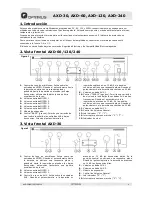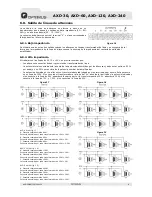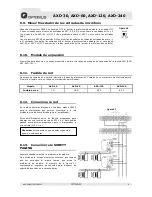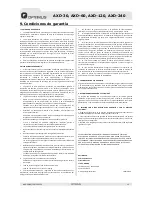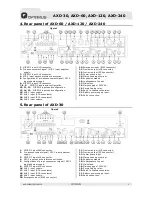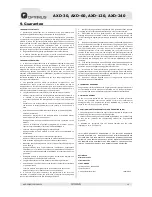
AXD-30, AXD-60, AXD-120, AXD-240
AXD-30/60/120/240 v1.3
4
1.
Introduction
These four models are integrated amplifiers of 30, 60, 120 and 240W respectively, designed for use in all kinds of
fixed public address systems that broadcast emergency announcements and background music for offices, restaurants,
churches, etc.
The amplifiers have thermal protection to avoid failures due to overheating. The protection system is reinforced by
fuses.
As a general rule, it is recommended that no operation should be performed on the inside of the amplifier, the
connectors or the terminals, when the amplifier is connected to the AC or DC supply.
These amplifiers have been designed to meet Electrical Safety and Electromagnetic Compatibility standards.
2.
Front view of AXD-60/120/240
1.
Microphone tone control: Acts on the MICRO
inputs. By turning the potentiometer towards the
right, a flat response is obtained; by turning it
towards the left, low frequencies are decreased,
and so it is easy to obtain optimum voice
equalization.
2.
MICRO 1 input volume.
3.
MICRO 2 input volume.
4.
MICRO 3 input volume.
5.
MICRO 4 input volume.
6.
MICRO 5 input volume.
7.
Expansion module.
8.
BASS control: Varies the signal level of the AUX
inputs at low frequencies. By turning the
potentiometer to the left, the bass is decreased by
10 dB. In the central position a flat response is
obtained. By turning the potentiometer to the right,
the bass is increased by 10 dB.
9.
AUX 1 input volume.
10.
TREBLE control: Varies the signal level of the AUX
inputs at high frequencies. By turning the
potentiometer to the left, the treble is decreased by
10 dB. In the central position a flat response is
obtained. By turning the potentiometer to the right,
the treble is increased by 10 dB.
11.
AUX 2 input volume.
12.
General Volume Control.
13.
LED indicator ( “0” / “I” ).
14.
On/Off switch ( “0” / “I” ).
15.
Level indicator.
3.
Front view of AXD-30
1.
Microphone tone control. Acts on the MICRO
inputs. By turning the potentiometer towards the
right, a flat response is obtained; by turning it
towards the left, low frequencies are decreased,
and so it is easy to obtain optimum voice
equalisation.
2.
MICRO 1 input volume.
3.
MICRO 2 input volume.
4.
AUX tone control. Acts on the AUX inputs. By
turning the potentiometer to the left, low
frequencies are decreased by 10 dB. In the central
position a flat response is obtained. By turning the
potentiometer to the right, high frequencies are
increased by 10 dB.
5.
AUX 1 input volume.
6.
AUX 2 input volume.
7.
Expansion module.
8.
General Volume Control.
9.
LED indicator (“0” / “I”).
10.
On/Off switch (“0” / “I”).
Figure 1
Figure 2



